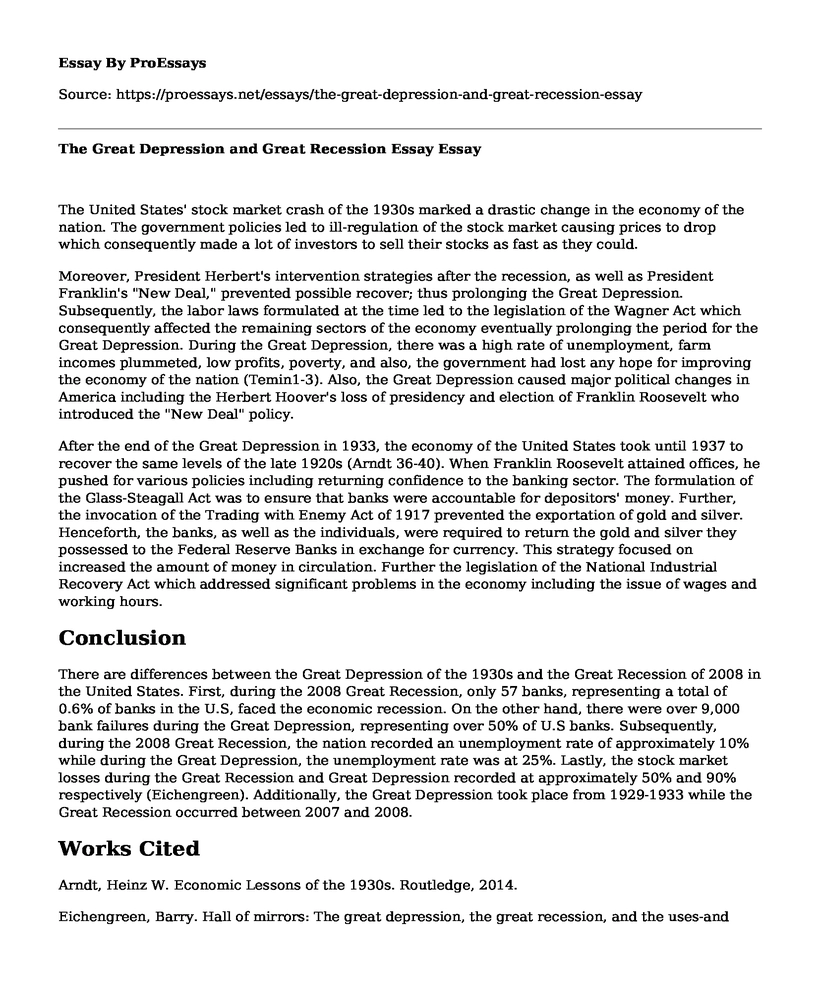The United States' stock market crash of the 1930s marked a drastic change in the economy of the nation. The government policies led to ill-regulation of the stock market causing prices to drop which consequently made a lot of investors to sell their stocks as fast as they could.
Moreover, President Herbert's intervention strategies after the recession, as well as President Franklin's "New Deal," prevented possible recover; thus prolonging the Great Depression. Subsequently, the labor laws formulated at the time led to the legislation of the Wagner Act which consequently affected the remaining sectors of the economy eventually prolonging the period for the Great Depression. During the Great Depression, there was a high rate of unemployment, farm incomes plummeted, low profits, poverty, and also, the government had lost any hope for improving the economy of the nation (Temin1-3). Also, the Great Depression caused major political changes in America including the Herbert Hoover's loss of presidency and election of Franklin Roosevelt who introduced the "New Deal" policy.
After the end of the Great Depression in 1933, the economy of the United States took until 1937 to recover the same levels of the late 1920s (Arndt 36-40). When Franklin Roosevelt attained offices, he pushed for various policies including returning confidence to the banking sector. The formulation of the Glass-Steagall Act was to ensure that banks were accountable for depositors' money. Further, the invocation of the Trading with Enemy Act of 1917 prevented the exportation of gold and silver. Henceforth, the banks, as well as the individuals, were required to return the gold and silver they possessed to the Federal Reserve Banks in exchange for currency. This strategy focused on increased the amount of money in circulation. Further the legislation of the National Industrial Recovery Act which addressed significant problems in the economy including the issue of wages and working hours.
Conclusion
There are differences between the Great Depression of the 1930s and the Great Recession of 2008 in the United States. First, during the 2008 Great Recession, only 57 banks, representing a total of 0.6% of banks in the U.S, faced the economic recession. On the other hand, there were over 9,000 bank failures during the Great Depression, representing over 50% of U.S banks. Subsequently, during the 2008 Great Recession, the nation recorded an unemployment rate of approximately 10% while during the Great Depression, the unemployment rate was at 25%. Lastly, the stock market losses during the Great Recession and Great Depression recorded at approximately 50% and 90% respectively (Eichengreen). Additionally, the Great Depression took place from 1929-1933 while the Great Recession occurred between 2007 and 2008.
Works Cited
Arndt, Heinz W. Economic Lessons of the 1930s. Routledge, 2014.
Eichengreen, Barry. Hall of mirrors: The great depression, the great recession, and the uses-and misuses-of history. Oxford University Press, 2014.
Temin, Peter. "Great Depression." Banking Crises. Palgrave Macmillan, London, 2016. 144-153.
Cite this page
The Great Depression and Great Recession Essay. (2022, Sep 22). Retrieved from https://proessays.net/essays/the-great-depression-and-great-recession-essay
If you are the original author of this essay and no longer wish to have it published on the ProEssays website, please click below to request its removal:
- Ancient Egyptian-Byzantine Empire
- America Policing the World - Essay Sample
- Wolfgang Amadeus Mozart Paper Example
- America Divided: The Civil War of the 1960s - Essay Sample
- Essay Example on Renaissance Era: Music & Universe Changes (1450-1600)
- Unemployment & Poverty: Sub-Sahara's Woes & Economic Fluctuations - Essay Sample
- Global History Highlights - Free Report







